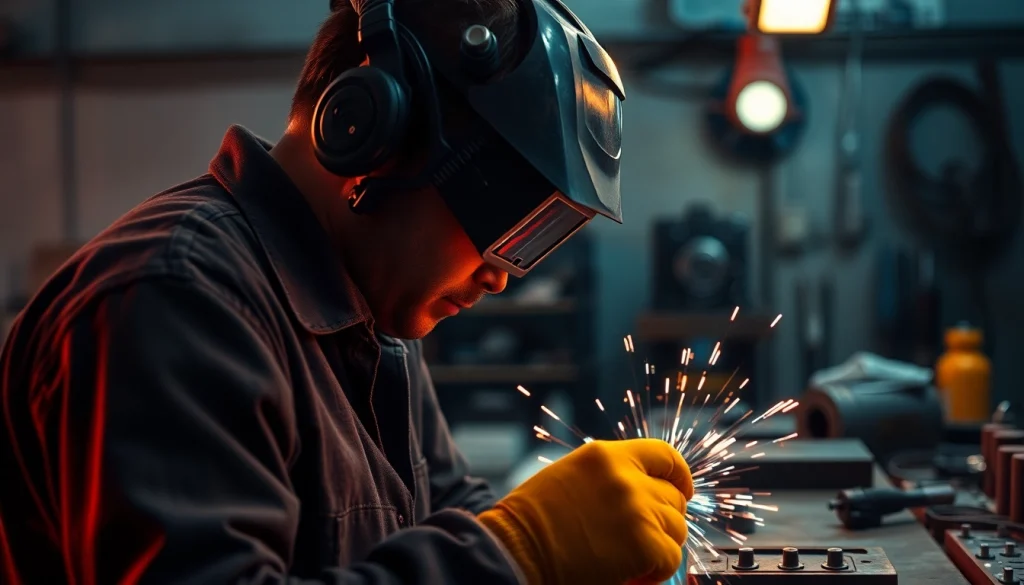Understanding Welding Supplies: An Introduction
Welding supplies encompass a wide variety of tools, equipment, and protective gear necessary for executing welding jobs safely and effectively. These supplies are crucial for both hobbyists and professionals engaged in various welding processes. Whether you are working on a DIY project or in an industrial environment, having the right welding supplies can make a significant difference in the quality of your work. In this guide, we will explore everything you need to know about welding supplies, from essential equipment to advanced tools, while also highlighting where to buy them, maintaining their longevity, and understanding the evolving landscape of welding technology.
What Are Welding Supplies?
Welding supplies refer to the various items required for welding tasks, which includes equipment used to create welds, consumables that are used during the welding process, and safety gear essential for protecting the welder. The primary categories of welding supplies can be divided into the following:
- Welding Equipment: This includes the welding machines themselves, such as MIG (Metal Inert Gas), TIG (Tungsten Inert Gas), and Stick welders, along with plasma cutters.
- Welding Consumables: These are materials that are consumed during the welding process, such as electrodes, filler rods, and shielding gas.
- Safety Gear: To protect welders from the hazards associated with welding, safety gear includes welding helmets, gloves, jackets, and protective eyewear.
Types of Welding Equipment and Tools
The welding process requires specialized equipment designed to achieve specific outcomes based on the project at hand. Here’s a closer look at the primary types of welding equipment:
- MIG Welders: Ideal for beginners due to their ease of use, MIG welders use a continuous wire feed and are suitable for welding thinner materials.
- TIG Welders: Known for producing high-quality welds, TIG welding involves a tungsten electrode and is used mainly for thin materials and precision work.
- Stick Welders: These machines are versatile and can be used in various positions, making them great for outdoor work and thick materials.
- Plasma Cutters: While not strictly welding equipment, plasma cutters are used to slice through metals and can complement welding tasks.
The Importance of Quality in Welding Supplies
Using high-quality welding supplies is essential for several reasons:
- Efficiency: Quality equipment can streamline the welding process, reducing the time and effort needed to achieve desired outcomes.
- Safety: Inferior supplies can lead to accidents and injuries. Quality welding gear conforms to safety standards, protecting the welder from hazards.
- Durability: Investing in high-quality tools ensures longevity and decreases the costs associated with frequent replacements.
Essential Welding Gear for Beginners
For those new to welding, having the right gear is vital for ensuring both safety and effectiveness as they develop their skills. Here are some essential welding supplies every beginner should consider:
The Must-Have Welding Supplies for New Welders
As a beginner, it’s crucial to equip yourself with the right tools to achieve success in your welding journey. Some of the must-have supplies include:
- Welding Helmet: A quality welding helmet filters harmful light and offers face protection from sparks and spatter.
- Welding Gloves: The right gloves provide insulation from heat and protect hands from heavy metal pieces and contaminants.
- Welding Jacket: A flame-resistant jacket protects the welder’s skin from heat and ultraviolet rays emitted during welding.
- Respirator: Depending on the environment, a respirator may be necessary to safeguard against harmful fumes and gases.
Choosing the Right Welder for Your Needs
Selecting the appropriate welder depends greatly on your specific project requirements and expertise level. Consider the following factors:
- Material Type: Different welders work best with specific types of metal; knowing your project’s material is crucial.
- Thickness of Material: Some welders excel with thicker materials, while others are designed for thin sheets.
- Welding Position: If you require flexibility in positions, a multi-process welder might be the best option.
Basic Safety Gear Every Welder Should Own
Safety should always be a priority when welding. Basic safety gear includes:
- Welding Helmets: Essential for eye protection and securing against sparks and ultraviolet light.
- Heavy-Duty Gloves: For hand protection against heat and sharp or rough materials.
- Apron or Jacket: A flame-resistant garment that minimizes the risk of burns from sparks or molten materials.
- Safety Footwear: Sturdy boots with steel toes help protect feet in hazardous environments.
Advanced Welding Supplies for Professionals
For seasoned welders, access to advanced welding supplies is essential for tackling complex projects that require precision, durability, and performance.
Specialized Tools for Different Welding Techniques
Professional welders often utilize specialized tools tailored to specific welding techniques. Some of these tools include:
- Multi-Process Welders: Perfect for experienced welders, these devices handle various welding processes (MIG, TIG, Stick) in one unit.
- Fume Extractors: Important for maintaining air quality, these tools capture harmful fumes produced during welding.
- Welding Positioners: Allow the welder to manipulate workpieces for better access and improved weld quality.
High-Performance Welding Equipment
Investing in high-performance welding equipment brings several benefits, such as:
- Enhanced Efficiency: Professional-grade equipment can significantly reduce welding time while maintaining high quality.
- Consistent Results: Quality machines ensure uniform welds, reducing the likelihood of errors due to equipment failure.
- Advanced Features: Many high-quality welders come with modern features like digital displays and digital controls, offering better precision.
Innovations in Welding Supplies
The field of welding is constantly evolving, with new tools and technologies enhancing the process. Some notable innovations include:
- Automated Welding Systems: Robots and automated systems improve consistency and speed in high-volume production settings.
- Weld Monitoring Systems: These advanced systems use sensors to monitor the welding process in real time, ensuring quality control.
- Environmentally Friendly Consumables: The introduction of eco-friendly filler materials and gases that reduce harmful emissions.
Where to Buy Quality Welding Supplies
Finding reliable sources for welding supplies is crucial for saving time, ensuring quality, and achieving better cost-effectiveness in your projects. Here are some options to consider:
Online Retailers for Welding Equipment
The convenience of online shopping allows welders to explore extensive inventories of welding supplies without geographical limitations. Some popular online retailers include:
- Cyberweld: Known for a wide selection of brands like Miller® and Lincoln Electric®, offering competitive prices.
- WeldingSupply.com: Provides a comprehensive range of welding equipment and consumables with easy online ordering.
- Harbor Freight Tools: Offers a variety of welding supplies, perfect for budget-conscious welders.
Choosing Local Suppliers for Immediate Needs
For urgent needs, local suppliers can be beneficial. They often provide:
- Personalized Service: Local suppliers can offer expertise and tailored recommendations based on your specific needs.
- Quick Access: In case of equipment failure or urgent project requirements, local shops often provide same-day service.
- Support Local Businesses: Choosing local suppliers keeps the craftsmanship and business thriving in your community.
Comparing Prices and Quality Across Brands
When purchasing welding supplies, comparing prices across different brands and suppliers ensures that you get the best deal without compromising on quality. Here are some tips for effective comparison:
- Read Reviews: Customer reviews can offer insights into the performance and durability of specific products.
- Check Return Policies: Make sure any purchase can be returned or exchanged if it does not meet your expectations.
- Look for Bundles: Many suppliers offer bundled deals that can save you money when purchasing multiple items at once.
Best Practices for Maintaining Your Welding Supplies
Proper care and maintenance of welding supplies ensure longevity and reliability. Here are several effective practices:
How to Care for Your Welding Equipment
The lifespan of welding equipment can be significantly extended with the right care. Here are some maintenance tips to keep your equipment in prime condition:
- Regular Inspection: Conduct routine examinations of all equipment to identify signs of wear or damage.
- Clean After Use: Clean all surfaces, especially near the welding area, to prevent debris buildup that can cause issues.
- Follow Manufacturer Guidelines: Each piece of equipment comes with care instructions; following these can prevent premature failure.
Storage Tips for Welding Supplies
Proper storage of welding tools and equipment helps prevent damage and facilitates easier access when needed. Consider these tips:
- Dry Environment: Store welding supplies in a dry place to prevent rust and corrosion.
- Organized Shelving: Use organized shelving units with designated spaces for different types of tools to keep everything accessible.
- Protective Cases: High-value equipment should be stored in protective cases to avoid shocks and impacts.
Recognizing When It’s Time to Replace Your Gear
Welding supplies have limited lifespans, and knowing when to replace gear can prevent safety hazards and inefficiencies. Here are some indicators:
- Frequent Breakdowns: If a machine requires constant repairs, it may be more cost-effective to replace it.
- Inconsistent Performance: Difficulty achieving consistent welds can suggest it’s time for an upgrade.
- Increased Maintenance Costs: If maintenance costs continue to rise, consider investing in new supplies that guarantee reliability.


